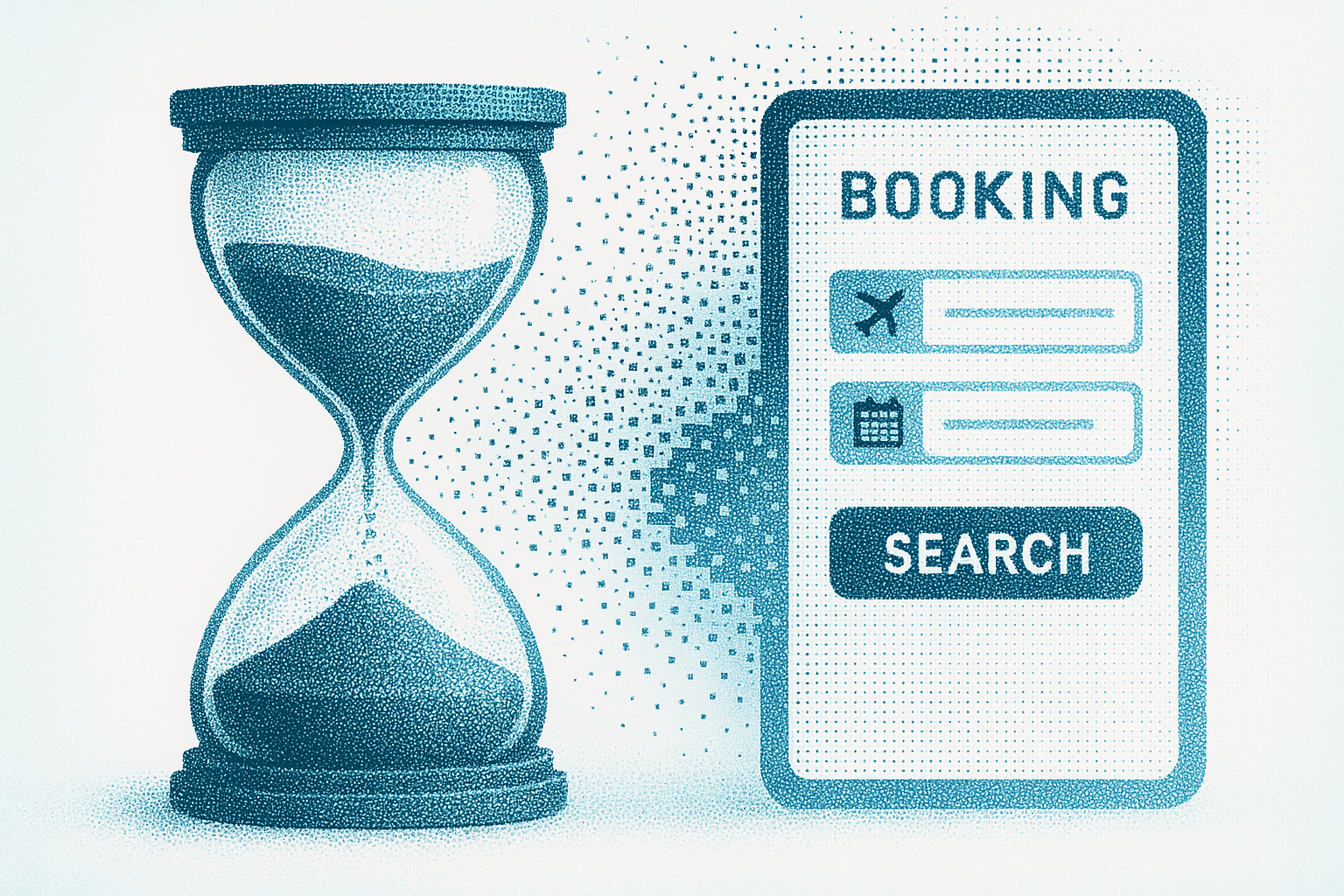Self-Booking Tools for Business Travel: A Complete Guide
Self-booking tools for business travelers: compare consumer sites, corporate OBTs, expense platforms, and AI assistants to find your fit.

If you book your own business travel, you know the drill. Each time, you re-enter your frequent flyer number, search for the same hotel near your client's office, dig through Slack to find which credit card to use, and check the nightly cap so finance won't reject your expense report three weeks later.
You're stuck in the gap between consumer booking sites that don't understand business travel needs and expensive enterprise solutions your company can't justify. Only 35% of global business travel spending goes through travel management companies. Everyone else falls into this middle ground: no TMC support or dedicated travel department, just consumer sites built for vacation planning that leave you stranded when flights cancel at 10 p.m.
This guide shows you what this gap costs in time and focus, what different types of self-booking tools offer, and how AI-powered platforms like Otto the Agent eliminate the manual work instead of just digitizing it.
What is the Real Cost of Manual Self-Booking?
Manual self-booking drains time, focus, and money. Here's what happens on every trip when you do everything alone:
Every booking starts from scratch. You re-enter preferences, juggle status numbers and loyalty programs, and recall which credit card to use. Your brain becomes the database.
Policy violations slip through because no system checks your choices up front. You book the nicer hotel that exceeds the nightly cap, and finance rejects the expense report three weeks later. You spend another hour explaining the overage, or eat the cost yourself.
Disruptions leave you stranded. Your flight gets canceled, and you're on hold for two hours instead of sleeping before tomorrow's client meeting.
Your trip details scatter across emails, calendars, and paper receipts. You book a flight, then manually copy the details to your calendar. When your colleague asks when you're back, you're searching through confirmation emails. Meanwhile, paper receipts and missing taxi slips pile up, delaying your expense report for weeks.
What are Self-Booking Tools for Business Travel?
Self-booking tools are platforms that let you search, compare, and book travel without calling a travel agent or going through a traditional travel management company. Most consolidate business travel into a single platform and automate some repetitive work. They let you compare flights and hotels from one dashboard instead of visiting multiple airline and hotel websites separately, with up-to-date prices and live availability that reduce the risk of booking outdated rates. Self-booking tools break down into four main categories:
Consumer booking sites like Expedia, Kayak, and Booking.com were designed for leisure travel. They offer centralized search, mobile apps, and self-service booking, but they optimize for the lowest price and family-friendly options. They don't understand business travel needs like flexible cancellations, loyalty status, or company policy compliance. Most lack expense tracking integration or policy enforcement features.
Corporate online booking tools (OBTs) like SAP Concur and Navan serve large enterprises with dedicated travel programs. They save frequent flyer numbers, loyalty memberships, and trip preferences to cut down on repetitive entry. They integrate company travel policies to flag non-compliant options, track bookings automatically, and sync to expense reporting platforms for easier reimbursement. You can book and manage trips from mobile apps and make simple changes like date updates or seat selections directly in the platform. But they require contracts, implementation, and usually serve companies with 200+ employees who have formal travel management programs.
Expense management platforms like Brex and Ramp have added travel booking features to their corporate card and reimbursement products. They offer basic search and booking functionality with a focus on spend visibility and simplified policy enforcement, but typically lack the robust travel features that dedicated booking platforms provide.
AI travel assistants represent a newer class of self-booking tools. Platforms like Otto use conversational AI and machine learning to automate booking and management tasks, handling the complex personalization, disruptions, and compliance that traditional self-service tools neglect. They deliver the same core booking and tracking features as other platforms, plus advanced automation that learns preferences and handles changes proactively.
Where are the drawbacks of Self-Booking Tools?
Self-booking tools consolidate options and store basic information, but they don't eliminate the fundamental problem: you're still doing all the work.
They save preferences but don't learn patterns. Most self-booking tools store your frequent flyer number and preferred airline. That's data storage, not intelligence. You still search, filter, and compare every time. The platform doesn't notice you always book morning flights for client meetings or prefer hotels within walking distance. You're clicking through the same decision tree on every trip instead of getting options that match what you actually do.
Servicing still falls on you. Your flight gets delayed and your connection becomes impossible. Most self-booking tools show you the delay. Some send an alert. But you handle the rebooking—searching alternatives, calling the airline, figuring out if you need a hotel, and updating your calendar and meetings. The platform helped you book, then disappeared when you needed it most.
Policy enforcement happens after you book. Corporate OBTs flag non-compliant bookings. But many self-booking tools either don't check policy or only validate after you submit for reimbursement. You book the hotel that seemed reasonable, then finance rejects your expense report three weeks later because it exceeded the cap you didn't know about. Now you're writing explanation emails or eating the cost.
Integration gaps create manual work. Your flight confirmation lives in the booking platform. Your meeting lives in your calendar. Your expense report lives in another system. Most self-booking tools don't connect these pieces. You're copying flight details to your calendar, forwarding confirmations, and manually uploading receipts weeks later.
You're managing loyalty programs alone. Self-booking tools store your frequent flyer numbers for major carriers and hotel chains. But tracking which programs offer the best value for each route, which credit card earns bonus points with which airline, and ensuring bookings qualify for status—all that strategy lives in your head. The platform books the flight. You optimize the value.
Complex trips expose the limitations. Simple round-trips work fine. Try coordinating a multi-city itinerary where flight timing affects hotel check-in and meeting schedules, and you're back to juggling browser tabs. Self-booking tools handle single transactions well. They struggle with interconnected decisions and timing dependencies.
The pattern is consistent: self-booking tools digitize the booking process without changing who does the thinking, planning, and problem-solving. You're still the travel manager. The platform just executes your decisions faster.
How Otto Delivers a Better Self-Booking Experience
Otto works differently from other self-booking platforms by acting like an executive assistant who handles the details without being asked.
Otto learns what you actually prefer, not just what you say you prefer. Otto scans your booking history and notices you always pick morning departures for client meetings but red-eyes after conferences. You search "Chicago" and Otto knows you mean the Highland Park location, not downtown. Window seat on the right side of the plane? Otto remembers that pattern without you teaching it explicitly.
Otto applies your loyalty numbers automatically and tracks your status across platforms. Otto adds your hotel and airline accounts to every booking without manual entry. Otto prioritizes flights that qualify for upgrades or complimentary seat selection based on your status level. You never lose points because a number wasn't applied correctly.
Policy checks happen as you browse. Otto flags any option outside your price caps or preferred suppliers before you click book. Those expense report rejections that show up weeks later never happen.
Otto proactively handles disruptions. Unlike other self-booking tools, Otto monitors your trip 24/7. Your flight gets canceled. Otto immediately presents rebooking options. You wake up to solutions instead of spending your morning on hold with customer service.
You just describe what you need. You talk to Otto like you're texting an assistant. Otto builds the itinerary with your loyalty numbers already applied. No multi-step forms or checkout pages. Just a conversation that ends with confirmed travel.
Otto supports you across devices. Book on your laptop during the day. Make changes from your phone at the airport. Your calendar stays synced automatically. Flight times, hotel check-ins, and meeting locations all appear where you need them. No more manually copying confirmation details or wondering if you updated the right calendar.
You pay nothing. Otto gets paid by airlines and hotels through standard commission structures. No subscription fees or booking charges for you.
Finding the Right Self-Booking Tool for Your Business Travel
Self-booking tools solve real problems for business travelers who don't have access to travel management companies. They bring your bookings into one place, save your loyalty numbers, help you stay within policy, and give you mobile access to manage trips on the go. These are meaningful improvements over juggling multiple consumer sites and spreadsheets.
But most self-booking tools still make you drive every step. They digitize the manual work instead of eliminating it. You're still clicking through forms, re-entering preferences that should be remembered, and handling disruptions alone when flights cancel.
Otto works differently by learning your actual travel patterns, enforcing policy before you book, and handling disruptions while you sleep. You describe what you need like you're texting an assistant, and Otto does the rest. Try Otto on your next business trip and spend your energy on the meeting instead of the logistics.



